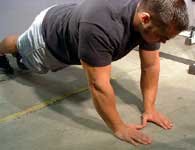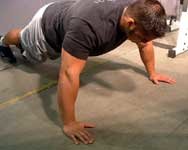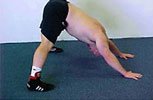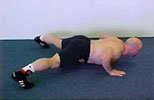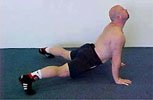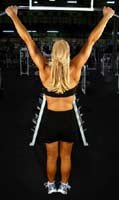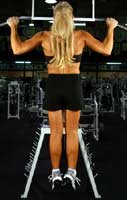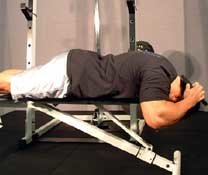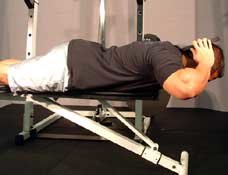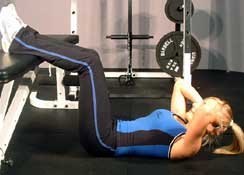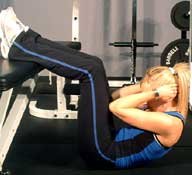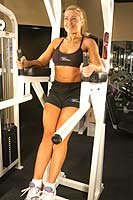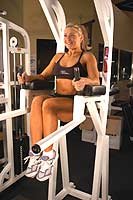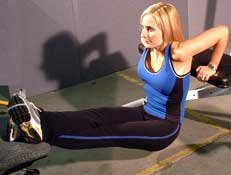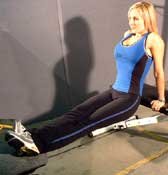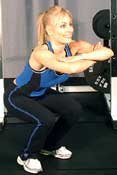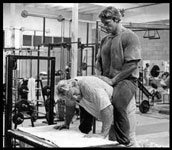It is generally accepted that 4-7 days rest is sufficient for most body parts, with 25-36 hours rest between actual sessions. Consistently training with this in mind will help to ensure results. Indeed, a perfect world scenario would have it that one train in the gym at a certain time for a certain time, with layoff periods structured in accordingly. However, we do not live a perfect world and missed workouts are an inevitable part of a bodybuilders life.
There are holidays, gym closure days, or one may not simply may not be able to get to the gym for a particular reason. Still, there is no need to miss a planed workout when there are many very effective, unconventional, non-gym exercises at ones disposal. Sometimes it is advantageous to train away from the gym.
Variety, a new training stimulus, and functionality are three reasons that come to mind. Exercises that don’t involve free weights or machines but, instead, involve bodyweight help to develop functional strength.
Increased functional strength can help one break through a plateau because functionally geared exercises typically work the stabilizing muscles, surrounding tendons, and ligaments as opposed to strictly isolating the muscle as do many conventional exercises.
Bruce Lee was a proponent of this style of training. He called it Real World Power training. I feel that non-gym training complements gym training in light of its functionality. This article will outline and overview the best non-gym exercises, and provide routines incorporating these exercises. Lets go to it.

The Exercises

Given that this is a non-gym training article it is assumed that one does not have access to conventional exercise equipment (dumbbells/barbells/bench press etc) of any type. The purpose of this article is to provide exercises that are effective substitutes for conventional exercises and can be done by virtually anyone, anywhere.
The Press-Up (chest/shoulders)
Probably the best known non-gym exercise, the press up is versatile and can be performed a number of different ways. A reasonable substitute for the “gold standard� of exercises, the bench press, provided intensity is emphasized above all. Ways to increase press-up intensity include: performing more reps, varying hand spacing, super-setting with hand spacing, and adding weight.
A good goal with press-ups is to try and do as many repetitions as possible at the start of each session. This is a great test of strength and endurance. Close, wide and medium hand spacing can be used to target a different aspect of the chest. Super-setting these grips by performing a set with each grip and quickly moving on to the next will increase intensity also.
Having someone sit, or apply downward pressure will add resistance and increase intensity. The great thing with the press-up is that one does not have the worry of a bar getting stuck or falling, and can concentrate 100% on each rep.
A good variation on the press-up is the Hindu press-up. The Hindu press-up is performed by starting in a regular press-up position with the back bent. With a swinging circular motion drop down and up. Then push back toward your heels and start over. This exercise really works all aspects of the chest.
Hand Stand Push-Ups (shoulders)
For this exercise stand on hands and place feet against a wall. Next perform a press-up motion, like an upside down military press without the bar. A couple of books, to place hands on, will increase the range of motion when one becomes proficient.
This exercise can produce astonishing results if done with strict form as the arms are literally stabilizing the shoulders, and the shoulders are supporting all of the bodyweight.
 Lateral Raises (shoulders; side deltoid mainly)
Lateral Raises (shoulders; side deltoid mainly)
For this exercise use four two-liter milk containers filled with water. Hold two containers in each hand and perform regular lateral raises. Can be super-setted with front raises (with the same containers) for excellent results.
Chin-Ups (back/biceps)
The chin-up is arguably the single most important exercise for overall back development. Ideally it is performed with ones bodyweight, until a least 15 reps can be completed with perfect form. This exercise, like the preceding two, can be done virtually anywhere (the only limiting factor being the imagination).
A steel bar across two beams in a garage or on the bars of a local kids playground. A complete back and biceps workout can be completed with the humble chin-up. A wide grip will target the outer lats and inner forearm. A medium grip will evenly disperse the stress across the lat region.
A close grip (hands almost touching) will work lower back, biceps and forearms. Reverse grip chin-ups will really place the emphasis on biceps and forearms. Conventional grip will emphasize the back more.
Neck Bridge (neck/trapezius)
This is probably the best exercise for total neck development. The trapezius is worked secondarily. This exercise will also strengthen the back from upper lat to the erectors. The key to performing it correctly is to lie on ones back, place hands either side of the head and then press off while arching the back.
The forehead must touch the ground with the neck bent backward. Try to keep the hands touching the ground for the first few sessions, or until strength has developed sufficiently in the neck region.
The goal is to perform this exercise without hands touching the ground. Extreme caution is advised when beginning this exercise. Use arms to support bodyweight from beginner through to advanced stages.
Neck Raises (rear neck region)
Excellent for building size at the back of the neck. This exercise involves placing a relatively light weight (5kgs) across the back of the head while neck is horizontal to the ground. Then simply lift neck back and contract (try to touch base of skull to upper trapezius).
Crunches (abdominal region; lower and upper)
This exercise can be done with the feet raised or tucked under a bed or up against a wall. The key is to keep the tension on the abbs throughout the entire range of motion. 100 reps is a good target.
Hanging Leg Raises (abdominal and upper thigh)
To accomplish place elbows on the ledge of step or the landing on a playground and then simply swing the legs up and down in a controlled motion. Can be done with the knees bent of legs straight. Straight legs tend to target primarily the lower abbs.
Triceps Dips (triceps)
Triceps dips can be done two ways. One way of performing triceps dips is to place each hand on the end of a chair with the legs elevated (on a table for example). Dip down and up for as many reps as possible. When dipping down try to touch shoulders to ears for a full range of motion.
Another way of performing this exercise is to place each hand on a bar or other similar object and dip down and up with the legs straight as opposed to elevated. This has a secondary effect on the lower chest region.
Free Standing Squats (quadriceps/hamstrings)
Free standing squats can be done with the arms folded across the chest. Definitely go below parallel as the lack of weight will enable this, provided correct squatting form is used. Since squatting is probably the number one exercise of them all, it should be included when is unable to train in the gym.
Aim for many repetitions (100+) to increase stamina and maintain size. A variation on free-standing squats are Hindu squats. To perform, stand upright and keep hands to the side. Raise heels off the ground during descent, and touch backside to calves. Then, explode up while swinging arms forward.
Once there pull arms back to side. Hindu squats tend to target upper body more than free-standing squats. If only one exercise could be chosen for a work-out this would probably be it. For both free-standing, and Hindu squats, ensure that a deep breath is taken upon descent and expire during ascent.
Donkey Calve Raises (calves)
An excellent calve exercise the donkey calve raise can be performed with weight attached (one or two people sitting across ones back to be exact). Raise right up onto the toes and stretch all the way down.

The Routines

Body parts are typically trained as per a normal gym session. The only real difference, apart from the actual exercises of course, will be the number of exercises performed at each session. Most sessions will have only one exercise per body part, but the variations on this exercise will more than compensate for the lack of exercise variety.
Also, the rep range can be increased if weight is not sufficient. High reps with perfect form is ideal. Non-weight exercises provide an incentive to really perfect ones form. The following rep ranges and sets are guidelines only, and can be altered to complement ones training goals.
Routine One
-
Chest, Shoulders And Triceps
- Press-ups and Hindu-press ups: three sets each of 20-30 reps.
- Hand-stand push-ups: three sets, 5-10 reps until strength increases. Then 15+.
- Lateral raises: three sets, 15-25 reps. Can super set with front raises.
- Triceps dips (both versions): two sets, 10-15 reps.
 Click here for printable workout log!
Click here for printable workout log!
Routine Two
-
Back And Biceps
- Chin-ups (reverse grip narrow and wide): two sets narrow and two sets wide, 8-12 reps each.
- Ultra-close reverse chin-ups for biceps: three sets of 8-12 reps.
 Click here for printable workout log!
Click here for printable workout log!
Routine Three
-
Abs And Neck
- Neck bridge: five working up to 3-5 minutes each.
- Neck raises: three sets, 20 reps.
- Crunches: five sets, 50-100 reps.
- Leg raises: five sets, 15-20 reps.
 Click here for printable workout log!
Click here for printable workout log!
Routine Four
-
Legs
- Free-standing squats: three sets, 25-50 reps. Try to work up to 100+ reps.
- Hindu squats: three sets 15-20 reps.
- Donkey calve raises: five sets, 25-50 reps.
 Click here for printable workout log!
Click here for printable workout log!
My Own Improvisations
Improvisation is often the key when training away from the gym. As I do not, as yet, own a weight set and often train away from the gym for work reasons, my garage is full of contraptions designed for the express purpose of training. 10 two-litre milk bottles attached to an old bar are used for bicep curls.
The same bar hung between two ceiling rafters is then used for chin-ups. Unorthodox movements can have surprising results. For example, super-setting chin-ups with 20-30 second bursts on the boxing bag result in a great muscle pump. Likewise, press-ups with my son sitting on my back super-setted with triceps dips with 40 kilograms of concrete blocks on my lap.
For squats I might have my son (who weighs 35 kilograms) sit on my shoulders while I perform 100 reps. Then I might complete several sprints at the local park. Talk about an excellent quadriceps pump. Remember, the only limiting factor is ones imagination.
There you have it. A (fairly) comprehensive bodybuilding regime without having to enter the gym. These routines can produce excellent results because one can do them at home, thereby reducing travel and post-workout nutrition time. Also, the inherent change in training stimulus, functionality and variety of these routines makes them a worthy inclusion. Good luck.
References
- Little, J. (1994). Bruce Lee; Real World Power. Muscle and Fitness. May 1994 edition.
- Furey, M.(2004). Combat Conditioning. [On line] http://www.mattfurey.com/.
4 Tips For Working Out In Your Home!
Thanks,

